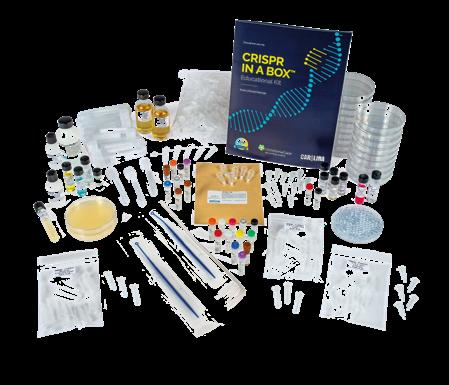


accelerates innovation to improve patient outcomes in Delaware and beyond.




accelerates innovation to improve patient outcomes in Delaware and beyond.
Driven by its urgent mission to develop disease-conquering therapies, the Gene Editing Institute both accelerates the science and hones the precision of gene editing. The scientific discoveries of the Institute have led to the development of a highly innovative lung cancer therapy to test CRISPR gene editing in solid tumors for the first time.
Together, we continue to bring genomic medicine to the forefront of cancer care.
The innovation by the researchers at the Gene Editing Institute is truly remarkable. They collaborate with oncologists and patients to unravel solutions that help improve cancer outcomes. I’m proud of their relentless pursuit of game-changing discoveries and their commitment to excellence.”
Janice E. Nevin, M.D., MPH, President and CEO of ChristianaCare
Our first focus was lung cancer, the leading cause of cancer death among Delaware adults. We found that modification of NRF2, a gene that overproduces protection in cancer cells, reduced tumor size and restored chemosensitivity. Foundational research on our initial target of lung cancer has allowed us to create a ‘plug-and-play’ model to streamline future efforts. Promising feedback from the Food and Drug Administration at our initial meeting led us to target other cancers.

Our team of scientists remains committed to innovating new gene editing tools that are fine-tuned to target cancer cells, leading to faster and more effective treatments.


CorriXR Therapeutics, ChristianaCare’s first spin-out company, has achieved major milestones. Through the development of a new pipeline design for bringing novel cancer targets from the bench and into pre-IND stages, CorriXR has proven to be an integral part of the Gene Editing Institute’s mission to get treatments to patients as quickly and safely as possible.
Significant investment allowed CorriXR to close seed funding ahead of target. Now poised for Series A financing, CorriXR advances as a transformative and successful preclinical biotechnology company.
Nicholas J. Petrelli, M.D., a nationally recognized expert on colorectal cancer and medical director of the Helen F. Graham Cancer Center and Research Institute, is a long-time supporter of the Gene Editing Institute and currently acts as one of its clinical advisors. We sat down with Petrelli to talk about our current collaboration and his hopes for the future of cancer care.
How would you describe your connection to the Gene Editing Institute?
My career has been centered on clinical and translational research as a clinician, and research that Dr. Kmiec has done throughout his career has been critical for cancer care. At the beginning, I put a clinical team together, which still exists today, to work with Eric and his team as the Gene Editing Institute evolved.
How does the Gene Editing Institute’s relationship to the Helen F. Graham Cancer Center and Research Institute shape the dynamic between scientists and clinicians?
I’ve told Eric from the very beginning that it’s dangerous for scientists, especially scientists working in cancer, to work in a black box. Working with a cancer center produces a collaboration and a proximity with the clinicians. This ensures that as the science progresses along, the clinicians can give input as to what will prove effective in patients.
What future could you predict for patient care with the continued research of CRISPR-Cas and other gene editing solutions?
I don’t have a crystal ball, but I do believe that what we’re doing today in genetics and genomics, even in ten years or less, is going to seem very embryonic. And that’s because the field is moving incredibly quickly. The ultimate goal in all of this is to improve the survival of patients with cancer, while at the same time ensuring that their quality of life improves while they’re in treatment. We need to minimize toxicity in side effects, and we need to focus on that in the future, no matter what the treatment is.
How do ChristianaCare’s values integrate with our research and innovation?
If you look at the core values and behaviors that were established by ChristianaCare, it’s all about empathy. There is an emphasis on compassion and transparency, and especially in the lab, it’s using resources wisely and ensuring that excellence moves us forward. Eric has also definitely embraced diversity and respect, which not only applies to the lab, but also in taking care of patients and working with your peers. Those values have really changed the culture in both of our arenas for the absolute better.
By identifying the most optimal targeting sites within genes and crafting an approach that can apply to additional tumor targets, we’re shaping cancer treatment for the future.”
- Deborah Moorad, MBA, Chief Executive Officer of
CorriXR Therapeutics

What advice do you have for the next generation planning to pursue genomic science?
You all have the capacity to be elite and excellent in your chosen career, but it takes three things. It takes passion, it takes commitment and it takes special focus, no matter what generation you are. That intelligence that you develop as you grow is only useful if you can apply it forward with a drive to combat these major diseases.

Founded in 2019, the education program at the Gene Editing Institute remains committed to demystifying gene editing for high school and college students. This year, we launched the Learning Lab, an innovative space for students to experience a gene editing experiment directly across from our lab space alongside our expert researchers. This experience prompts them to be science ambassadors and bring this knowledge back to their respective school and community, highlighting our mission to bring more perspectives and experiences into the novel field of gene editing.



The Gene Editing Institute proudly supports the next generation of scientists, not only through our Learning Lab, but in fostering local talent and providing them the resources, support, and space to flourish. Here, we highlight two case studies that elevated a student idea into a product changing the landscape of gene editing.
Kristen Pisarcik began her gene editing journey as a student intern through a collaborative grant between the Gene Editing Institute and Delaware Technical Community College. Her insight into the capabilities of our new in-vitro gene editing system spurred our creation and expansion of the Gene Editing 360™ program, with Pisarcik herself becoming one of its first testers. She later pursued her full undergraduate degree in Biotechnology, and now operates as a full-time staff scientist focusing on in-vitro screening for our future cancer projects.


We relaunched CRISPR in a Box™, our educational toolkit, with partner organization Carolina Biological, the premier supplier of science lessons and equipment for K-12 and collegiate institutions.
The new version provides teachers with the option of purchasing the kit with perishables or without perishables, enabling them to buy what they need. The complete kit costs 37.5% less than its previous iteration. This aligns with our mission to ensure that CRISPR education remains affordable and accessible to schools across the country, bringing more students into the lab space and increasing STEM literacy in this new and groundbreaking field.


Sarah LaTorre was one of the first people to participate in our Learning Lab. The experience inspired her to learn more about the institute, which then led her into an education intern position. Her innovation in designing the workshop led to a better student experience through her implementation of cooperative activities, PPE training, interactive quizzes that reinforced concepts learned in the lab and more opportunities to interface with staff scientists to ask career questions. Upon completing her bachelor’s degree, Sarah continued at the Gene Editing Institute as a full-time employee who will soon represent us on a national stage forthe National Association of Biology Teachers in Anaheim, CA.
High schooler Rohan Kanchana from Newark Charter School was intrigued by the fact that the best way to screen large populations of cells was too costly and time consuming to be practical for most labs. Meanwhile, his mentors noted that available alternatives to deep sequencing did not detect the full range of DNA mutations that may be introduced by a CRISPR gene repair.
Seeking to change this, Rohan worked in collaboration with the Gene Editing Institute to create DECODR™. DECODR™ (which stands for DEconvolution of COmplex DNA Repair) is a quantification tool for Sanger-sequencing data that has been edited by CRISPR. Its broad analysis window and more precise analysis of indels made it stand out amongst its competitors. Three independent studies on DECODR™ show clear advantages to using this software for analysis of somatic in-vivo gene editing, the most relevant testing to our field of research.



Thank you to our board, partners and supporters. Your contributions inspire us forward.

The future is promising – but there’s a long way to go.
There are new cancer targets that we find that could be viable targets, but require years of tenacious, drive-fueled research, testing, FDA approval, clinical trials and an implementation that can be afforded by the people contending with these diseases. That’s to say nothing of inherited disease. Orphan disease. Parkinson’s. HIV. Muscular dystrophy. The list goes on, and it can be overwhelming, as a research institute, to think about the possibility of addressing even a fraction of the diseases that impact the patients who depend on innovation like ours.
But I have never met a group of scientists so committed to chasing results, so dedicated to innovating our research. Tools that will shape the way we pursue gene editing by utilizing the body’s own methods of regulation are being developed right here by researchers still only a few years out of college. Students come into our lab space and ask questions that I’ve never heard before and make me recontextualize a gene I’ve been thinking about the same way for the past three decades. We’re fueled by our meetings with the FDA as we hear of new ways that our technology can impact cancer targets.
The future is growing fast. There’s a long road ahead, but I caution us not to forget how long the road traveled seemed to be before we traversed it. This team regularly humbles and astounds me, and whatever path we chart next, I am confident that this next stretch of innovative CRISPR research will change the landscape of this field for decades to come. I am proud to continue leading this team of researchers into a future where cancer care is more personalized, more effective and more accessible than ever before.
Walking the path forward,
Eric Kmiec, Ph.D.

